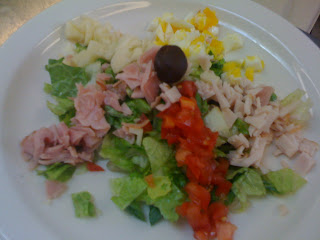 |
| Starch: No meal is complete without it |
I did ask my boss why once, he said most of the residents hated rice and spaghetti (they called any form of pasta spaghetti, regardless of shape). I took it as truth and forgot about it- quickly learning how to prepare potatoes every way, and just as quickly deciding I hated them.
I still believed it, up until my current job. I had almost forgotten about other starches, even ones I prepared at home but that didn't register in my brain for one reason or another. Then I encountered the "starch" box at work. My head chef keeps everything very organized; if you are looking for nuts in dry storage, check the nut box, flour- check the grain box. The potatoes (and sweet potatoes) are in a large box on the bottom shelf. But ah... the starch box. Polenta, long grain white rice, arborio rice, wild rice, brown rice, quinoa, bulgur, barley, millet, wheat berries... the list goes on. Next to the starch box, and closely related, we have the pasta box- filled to the brim with all shapes of noodles- spaghetti, lasagna, couscous, cavatappi, egg noodles, elbow macaroni, shells.... All avaliable to prepare and serve with the entree (or soup, or salad, or even dessert).
And the residents love it. They don't want potatoes all the time either! They are still human beings with the same (though slightly weaker) taste buds! Yes- potatoes can be yummy, and seniors do love them, but not everyday.
I totally understand the distaste for spaghetti (the actual spaghetti, angle hair, capellini, linguine and other long pastas)- the long awkward shapes, hard for trembling hands to swirl onto a fork, that slide too easily down your throat, before chewing, and can be hazardous. I myself have choked on spaghetti more times than I'd like to recall. But there are so many pasta shapes! I really like to use the short, flat, wide egg noodles- they have a unique flavor and are both easy to pick up and to eat- great for Stroganoff and casseroles, plus, I always use them when I make chicken noodle soup.
I think a lot of elderly residents dislike rice for the same reason, not that it's hard to swallow, but that it is harder to pick up with a fork. It also tends to get everywhere, so serving in a bowl might make clean-up easier. Risotto is an option too- it sticks together, making it much easier to pick up, and it's creamy and flavorful.
Of all the many grains, I have had the best luck with polenta. It's thick, creamy, and soft, and can be seasoned many ways. The residents love it; it sticks together, sticks to their utensils, stays on their plates (not the floor), is easy to chew (though not necessary) and easy to swallow, and just plain delicious. I usually stir in hot cream and Parmesan cheese at the end, or sauteed onions, mushrooms and thyme ( also one of my favorite risotto combinations). You can prepare it with water or a flavorful stock- just don't forget the salt!
Whatever starches you choose to accompany your meals, be sure to use a variety. Be open to new breeds and try new recipes. And don't forget about the potato!



